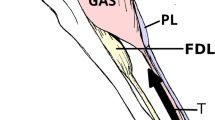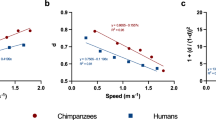Abstract
LARGE kangaroos are unique among mammals in their ability to uncouple aerobic metabolic energy costs from the speed of locomotion1,2, making hopping an economical gait. During the first half of the ground-contact phase, kinetic energy lost from the body is stored as elastic strain energy, predominantly in the hind limbs3–5. The subsequent recoil returns kinetic and potential energy to the body. Here we show that the allometry of structures in the legs and feet of Macropodoidea is different from that of quadrupedal eutherian mammals. The potential for elastic energy storage in hoppers is shown to scale with strong positive allometry. This is a function of the structural properties of muscle–tendon units in the distal hind limbs and the postures adopted by hopping kangaroos. Our findings demonstrate how the use of tissue elasticity is strongly mass dependent and help explain the observed energetic phenomena.
Similar content being viewed by others
References
Dawson, T. J. & Taylor, C. R. Nature 246, 313–314 (1973).
Baudinette, R. V., Snyder, G. K. & Frappell, P. B. Am. J. Physiol. 262, R771–R778 (1992).
Cavagna, G. A., Heglund, N. C. & Taylor, C. R. Am. J. Physiol. 233, R243–R261 (1977).
Alexander, R. McN. & Vernon, A. J. Zool., Lond. 177, 265–300 (1975).
Ker, R. F., Dimery, N. J. & Alexander, R. McN. J. Zool., Lond. (A) 208, 417–428 (1986).
Windsor, D. E. & Dagg, A.I. J. Zool., Lond. 163, 165–175 (1971).
Thompson, S. D., MacMillen, R. E., Burke, E. M. & Taylor, C. R. Nature 287, 223–224 (1980).
Alexander, R. McN. Elastic Mechanisms in Animal Movement (Cambridge Univ. Press, 1988).
Bennett, M. B. J. Zool., Lond. 235, 33–42 (1995).
Pollock, C. M. & Shadwick, R. E. Am. J. Physiol. 266, R1022–1031 (1994).
Bennett, M. B., Dimery, N. J., Ker, R. F. & Alexander, R. McN. J. Zool., Lond. 209, 537–548 (1986).
Biewener, A. A. Science 250, 1097–1103 (1990).
Alexander, R. McN., Maloiy, G. M. O., Njau, R. & Jayes, A. S. J. Zool., Lond. 187, 169–178 (1979).
Bennett, M. B. J. Zool. Lond. 212, 457–464 (1987).
Herzog, W., Leonard, T. R. & Guimaraes, A. C. S. J. Biomech. 26, 945–953 (1993).
Murray, P. in Vertebrate Palaeontology of Australasia (eds Vickers-Rich, P., Monaghan, J.M., Baird, R. F., & Rich, T. H.) 1071–1164 (Monash Univ. Publications Committee, Mel-bourne, 1991).
Farley, C. T., Glasheen, J. & McMahon, T. A. J. exp. Biol. 185, 71–86 (1993).
Author information
Authors and Affiliations
Rights and permissions
About this article
Cite this article
Bennett, M., Taylor, G. Scaling of elastic strain energy in kangaroos and the benefits of being big. Nature 378, 56–59 (1995). https://doi.org/10.1038/378056a0
Received:
Accepted:
Issue Date:
DOI: https://doi.org/10.1038/378056a0
- Springer Nature Limited
This article is cited by
-
Proportional variation and scaling in the hindlimbs of hopping mammals, including convergent evolution in argyrolagids and jerboas
Journal of Mammalian Evolution (2024)
-
Blood flow rate to the femur of extinct kangaroos implies a higher locomotor intensity compared to living hopping macropods
Journal of Mammalian Evolution (2024)
-
Distal Humeral Morphology Indicates Locomotory Divergence in Extinct Giant Kangaroos
Journal of Mammalian Evolution (2022)
-
Proximal Humerus Morphology Indicates Divergent Patterns of Locomotion in Extinct Giant Kangaroos
Journal of Mammalian Evolution (2020)
-
Running humans attain optimal elastic bounce in their teens
Scientific Reports (2013)





